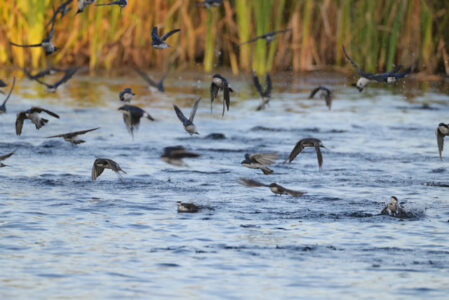Reflections in Nature: So what’s the difference between algae and scum?
Have you noticed the many ponds and backwater areas that are covered with green scum? The fishermen are upset because this scum fouls up their fishing lines and boat motors. Those who have fish tanks, in their homes or offices, also dislike the scum because it collects on the sides of their tanks.
Our word scum comes from the German word schaum, meaning foam. “You’re nothing but scum” and “You’re the scum of the Earth” are both unkind statements made to someone that is not liked; therefore, we can conclude that scum is not held in high regard by us humans.
Algae and scum are not the same; however, they are both commonly referred to as scum.
Scum that forms on the bottom and sides of a pond becomes buoyant and floats to the surface due to the oxygen bubbles it has produced. This pond scum can quickly cover the surface of the water with a green scum, giving the pond a dirty appearance.
Algae are plants, such as duckweed, water meal, water hyacinth, water lettuce, milfoil, hydrillia and curly-leaf pondweed that grow on top of the water. These plants can also cover the surface of a pond with a green scum.
Our word algae comes from the Latin word alga, meaning seaweed. The word seaweed is the English translation of the Latin word Alga. Seaweed is only one of possibly 20,000 species of algae on Earth and each type is slightly different from the others.
At first, primitive humans were leery of seaweed, fearing that certain seaweed was bewitched. Sorcerers used seaweed in weaving magic spells, however the ancient Chinese regarded seaweed as much as we do steak and chocolate cake.
A Chinese doctor was the first to recognize that seaweed had medicinal powers. Seaweed was prescribed for stomach disorders, goiters, abscesses, lung conditions and dropsy.
The ancient Polynesians used one type of algae to make a poultice for sore eyes and another type that worked as a laxative.
Early farmers used seaweed as a fertilizer to improve their soil. Laboratory research now reveals that the minerals in algae are very much like those put into our best artificial fertilizers. Recently, scientists have discovered that seaweed contains antibiotics that will keep food from spoiling.
Although the green algae seen growing on the water do not look appealing, they are important for a healthy lake. Algae use sunlight — through photosynthesis — to produce carbohydrates, which are eaten by zooplankton, such as water fleas. Iin turn, zooplankton are fed upon by small fish that are eaten by bigger fish and continue on up the food chain. Algae are the base of the food chain and essential to life in both lakes and ponds.
Algae might be our saving grace, plants that we could depend on in the future. Space travelers of the future might breathe oxygen that is emitted by the tiny plants that make up the scum on the pond.
Algae plants are the simplest form of life on Earth. Many algae have only one cell, no roots, no stems, no leaves and no flowers. The simplicity of algae are what make the plants ideally suited for use on spacecraft.
Algae would only need water, light, the carbon dioxide breathed out by the space travelers and the nitrogen and other minerals that can be found in the traveler’s daily waste.
Algae grows with incredible speed, therefore a small amount could continually produce oxygen on a trip to Mars and back to earth.
Algae can also be used as food for the spaceship travelers. A dish of algae doesn’t have to look or taste like green slime. An alga diet provides all the minerals, proteins, fats and starches that would be found in a full-course meal of roast beef, French fries, string beans, peaches and cookies.
True, the idea of using algae in space is something new and needs refinement, but algae are not new. Algae are the oldest form of life we know. The slime seen on the side of your fish tank and the scum on the pond looks exactly the way it looked when the dinosaurs roamed the earth.
Algae are everywhere. No matter where you go in the world, you will find algae plants. In the Antarctic, you’ll find red algae giving a pink glow to the glacial ice, and in the tropics, you’ll find algae floating on the warm waters.
In the future we may be growing algae. Crops of algae would need less space to grow on than other crops. For example, soybeans require 60 times as much space to grow than algae.
Another good point about algae is that there is no waste. At least half of every other vegetable or grain is thrown away. We take an ear of corn, pull off the husks, pick out the silk threads, and after the kernels are eaten, the cob is thrown away. The farmer has to dispose of the stalk and the roots.
Algae is a simple one cell plant and every bit of it can be eaten. Well, if algae are all that great, why aren’t we eating them now? The answer is that we do not have a shortage of the crops we are growing now.
However, algae could be our ace in the hole in the future.
Bill Bower is a retired Pennsylvania Game Commission Wildlife Officer. Read his blog and listen to his podcasts on the outdoors at www.onemaningreen.com.

